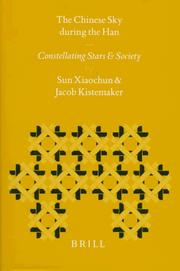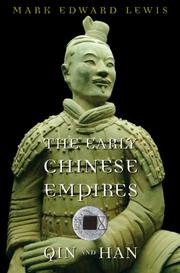| Listing 1 - 10 of 30 | << page >> |
Sort by
|
Book
ISBN: 9782251110226 2251110224 Year: 2016 Publisher: Paris: Les Belles Lettres,
Abstract | Keywords | Export | Availability | Bookmark
 Loading...
Loading...Choose an application
- Reference Manager
- EndNote
- RefWorks (Direct export to RefWorks)
Les Notes diverses sur la capitale de l'Ouest (Xijing zaji) nous offrent, sous la forme fragmentaire de brèves scènes et de descriptions sans organisation apparente, une vision éclatée, précise et étrange à la fois, de la glorieuse cité de Chang’an, capitale des Han occidentaux. Elles sont traditionnellement considérées comme une part des notes historiques rédigées par un grand lettré de l’époque des Han, Liu Xin (46 av. J.-C.-23 ap. J.-C.), c’est-à-dire celles qui, s’écartant trop de l’écriture orthodoxe de l’histoire, ne furent pas intégrées dans l’Histoire des Han (Han shu) rédigée par Ban Gu. De fait, cet ouvrage appartient au genre livre de notes, genre important dans l’histoire littéraire chinoise, dont il est un des fleurons. Il est un complément essentiel aux livres d’Histoire par son souci de véridicité et de détails, et il contient des anecdotes qui sont la première mention de faits qui seront ensuite repris et développés dans des ballades, des romans et plus tard à l’opéra. Au sein de la description fascinante des richesses et des fastes de la capitale, sont aussi évoqués des drames dans le gynécée impérial. Prise dans les tourments politiques de l’époque, la capitale de l’Ouest sera abandonnée en 23 de notre ère, l’année même de la mort de Liu Xin et les Han orientaux déplaceront leur capitale plus à l’Est, à Luoyang. Avec cette traduction par Jacques Pimpaneau, ce texte est pour la première fois accessible au lecteur français, qui est ainsi invité à parcourir les palais, les jardins et les tombes de la capitale disparue.
China --- Xi'an (Shaanxi Sheng, China) --- Chine --- Xi'an (Shaanxi, Chine) --- History --- Sources --- Histoire --- S04/0520 --- China: History--Han: 206 B.C. - 220 A.D --- Sources.
Book
ISBN: 9781438458229 1438458223 9781438458236 Year: 2016 Publisher: Albany State University of New York Press
Abstract | Keywords | Export | Availability | Bookmark
 Loading...
Loading...Choose an application
- Reference Manager
- EndNote
- RefWorks (Direct export to RefWorks)
Stephen Eskildsen offers an overview of Daoist religious texts from the Latter Han (25-220) through Tang (618-907) periods, exploring passive meditation methods and their anticipated effects. These methods entailed observing the processes that unfold spontaneously within mind and body, rather than actively manipulating them by means common in medieval Daoist religion such as visualization, invocations, and the swallowing of breath or saliva. Through the resulting deep serenity, it was claimed, one could attain profound insights, experience visions, feel surges of vital force, overcome thirst and hunger, be cured of ailments, ascend the heavens, and gain eternal life.While the texts discussed follow the legacy of Warring States period Daoism such as the Laozi to a significant degree, they also draw upon medieval immortality methods and Buddhism. An understanding of the passive meditation literature provides important insights into the subsequent development of Neidan, or Internal Alchemy, meditation that emerged from the Song period onward.

ISBN: 9789004107373 9004107371 9789004488755 9004488758 Year: 1997 Volume: 38 Publisher: Leiden Brill
Abstract | Keywords | Export | Availability | Bookmark
 Loading...
Loading...Choose an application
- Reference Manager
- EndNote
- RefWorks (Direct export to RefWorks)
A reconstruction of the Chinese sky of two thousand years ago, based on analysis of the first star catalogue in China and other sources. Presented in six well-sized star maps for 100 BC, it is especially important for the history of astronomy. The Han sky, with five times more constellations than Ptolemy knew, reflects diverse human activities. The way in which constellations were grouped discloses a systematic cosmology, uniting universe and the state. The work of the three Han schools is comparable to Ptolemy's Almagest . With three detailed Appendices on the constellations of the three schools, well illustrated to demonstrate the relation between sky and human society, this book is valuable not only for astronomy historians and sinologists, but in general for scholars interested in the ancient cultures of Asia.
Astronomy --- Constellations --- Astronomie --- Histoire --- China --- Chine --- History --- S19/0200 --- S04/0520 --- China: Natural sciences--Astronomy, chronometry, zodiac etc. --- China: History--Han: 206 B.C. - 220 A.D. --- Astronomy, Chinese. --- Constellations. --- Astronomy, Chinese --- Sky --- Chinese astronomy --- China: History--Han: 206 B.C. - 220 A.D --- China: Natural sciences--Astronomy, chronometry, zodiac etc
Book
ISBN: 0300027230 Year: 1982 Publisher: New Haven Londres Yale University press
Abstract | Keywords | Export | Availability | Bookmark
 Loading...
Loading...Choose an application
- Reference Manager
- EndNote
- RefWorks (Direct export to RefWorks)
S04/0520 --- S11/0450 --- S13A/0410 --- S17/0214 --- #SML: Joseph Spae --- China: History--Han: 206 B.C. - 220 A.D. --- China: Social sciences--Cities: general and before 1840 --- China: Religion--Death, funeral, ancestral worship --- China: Art and archaeology--Archaeology China: Pre-Han and Han --- China --- Antiquities. --- Civilization --- -History --- -S04/0520 --- -#SML: Joseph Spae --- China: History--Han: 206 B.C. - 220 A.D --- History
Book
ISBN: 9782251446387 2251446389 Year: 2020 Publisher: Paris Belles Lettres
Abstract | Keywords | Export | Availability | Bookmark
 Loading...
Loading...Choose an application
- Reference Manager
- EndNote
- RefWorks (Direct export to RefWorks)
Les deux premiers empires chinois, les dynasties Qin (221-207 av. J. -C.) et Han (206 av. -220 apr. J. -C.), forgèrent un système politique, des structures sociales, une organisation économique et des assises culturelles à la pérennité stupéfiante. L'unification que ces dynasties imposèrent, l'expansion territoriale et les brassages de populations induits, font de ces quatre siècles une époque charnière. Dû aux meilleures spécialistes, le présent ouvrage offre une remarquable synthèse sur l'histoire et la civilisation de cette période fondamentale, dont l'étude a été profondément renouvelée par les très nombreuses découvertes archéologiques de ces dernières décennies. -- Quatrième de couverture
Chine -- 221-207 av. J.-C. (Dynastie des Qin) --- Chine -- 202 av. J.C.-220 (Dynastie des Han) --- S04/0510 --- S04/0520 --- China: History--Pre-Han: before 206 B.C. --- China: History--Han: 206 B.C. - 220 A.D. --- China --- Chine --- History --- Histoire --- China: History--Pre-Han: before 206 B.C --- China: History--Han: 206 B.C. - 220 A.D
Book
ISBN: 9780295994055 Year: 2015 Publisher: Seattle University of Washington Press
Abstract | Keywords | Export | Availability | Bookmark
 Loading...
Loading...Choose an application
- Reference Manager
- EndNote
- RefWorks (Direct export to RefWorks)
S03/0605 --- S04/0520 --- S11/0605 --- S05/0210 --- China: Geography, description and travel--Shaanxi --- China: History--Han: 206 B.C. - 220 A.D. --- China: Social sciences--Folklore, festivals --- China: Biographies and memoirs--From ancient times until 589 --- China: History--Han: 206 B.C. - 220 A.D
Book
ISBN: 1438475144 9781438475141 9781438475134 1438475136 Year: 2019 Publisher: Albany, New York : State University of New York Press,
Abstract | Keywords | Export | Availability | Bookmark
 Loading...
Loading...Choose an application
- Reference Manager
- EndNote
- RefWorks (Direct export to RefWorks)
"In Literate Community in Early Imperial China, Charles Sanft looks at interactions with text during the Han period and argues that they were more widespread than has been recognized. Archaeologists have excavated a tremendous number of written materials left behind at military installations in the northwestern border regions of China, and scholars have often studied these documents for what they tell us about institutions. But their cultural aspects have received far less attention. Sanft brings an innovative interdisciplinary analytic framework to the study of these documents. He offers a new way to distinguish between reading and writing, which allows for an improved understanding of how text worked in early China, and concentrates on the community rather than the individual. In doing so, he is able to show that a much broader section of early society had meaningful interactions with text. This is a major shift from previous understandings, and makes Literate Community an important contribution to early China studies, the study of literacy, and the global history of non-elites"--
Chinese language --- Literacy --- Illiteracy --- Education --- General education --- Archaic Chinese language --- Proto-Chinese language --- Writing --- History. --- Archaic Chinese --- S04/0520 --- S15/0200 --- History --- China: History--Han: 206 B.C. - 220 A.D --- China: Language--General works
Book
ISBN: 9789056157784 9056157787 Year: 2021 Publisher: Place of publication unknown Noordboek
Abstract | Keywords | Export | Availability | Bookmark
 Loading...
Loading...Choose an application
- Reference Manager
- EndNote
- RefWorks (Direct export to RefWorks)
Schets van het dagelijks leven van Chinezen in het oude China aan de hand van de bezigheden van 24 Chinezen uit verschillende klassen en beroepsgroepen gedurende één uur van de dag. Welkom in Chang'an in het jaar 17. De Han Dynastie is op zijn hoogtepunt en de hoofdstad van het Chinese rijk is het bruisende middelpunt, zowel op economisch als cultureel gebied. Het is een dynamische en spannende tijd, maar de bevolking worstelt met de gebruikelijke problemen van werk, geld en familie. In dit boek brengen 24 uur door met 24 inwoners van de stad. Aan het woord komen onder anderen een arts, een grafrover, een danseres, een leraar en een vroedvrouw. Hun verhalen, en de kaderteksten met interessante aanvullende informatie, geven ons een helder beeld van hoe het was om in die boeiende tijd te leven. (bron: covertekst)
History --- dagelijks leven --- geschiedenis --- sociale geschiedenis --- China --- S04/0520 --- S11/0491 --- S11/0501 --- China: History--Han: 206 B.C. - 220 A.D --- China: Social sciences--Society before 1840 --- China: Social sciences--Daily life: before 1840

ISBN: 9780674057340 0674057341 9780674024779 067402477X Year: 2007 Publisher: Cambridge, Mass. Belknap Press of Harvard University Press
Abstract | Keywords | Export | Availability | Bookmark
 Loading...
Loading...Choose an application
- Reference Manager
- EndNote
- RefWorks (Direct export to RefWorks)
China --- History --- History. --- anno 100-199 --- anno 1-99 --- S04/0500 --- S04/0520 --- S06/0202 --- China: History--Ancient (Pre-Han and Han, incl. Sima Qian) --- China: History--Han: 206 B.C. - 220 A.D. --- China: Politics and government--Government and political institutions: Han - 589 --- Ancient history --- History of Asia --- Chine --- Histoire --- China: History--Han: 206 B.C. - 220 A.D --- China - History - Qin dynasty, 221-207 B.C. --- China - History - Han dynasty, 202 B.C.-220 A.D.
Book
ISBN: 9780521852975 0521852978 Year: 2010 Volume: 67 Publisher: Cambridge Cambridge university press
Abstract | Keywords | Export | Availability | Bookmark
 Loading...
Loading...Choose an application
- Reference Manager
- EndNote
- RefWorks (Direct export to RefWorks)
Geschichte 221 v. Chr. -220. --- China --- Chine --- History --- Antiquities. --- Histoire --- Antiquités --- Antiquities --- S04/0520 --- S04/0500 --- S17/0214 --- China: History--Han: 206 B.C. - 220 A.D. --- China: History--Ancient (Pre-Han and Han, incl. Sima Qian) --- China: Art and archaeology--Archaeology China: Pre-Han and Han --- Antiquités --- China: History--Han: 206 B.C. - 220 A.D --- China - History - Qin dynasty, 221-207 B.C. --- China - History - Han dynasty, 202 B.C.-220 A.D. --- China - Antiquities
| Listing 1 - 10 of 30 | << page >> |
Sort by
|

 Search
Search Feedback
Feedback About UniCat
About UniCat  Help
Help News
News